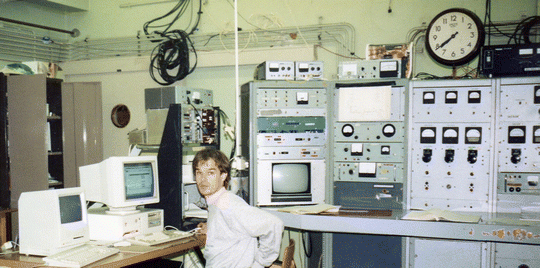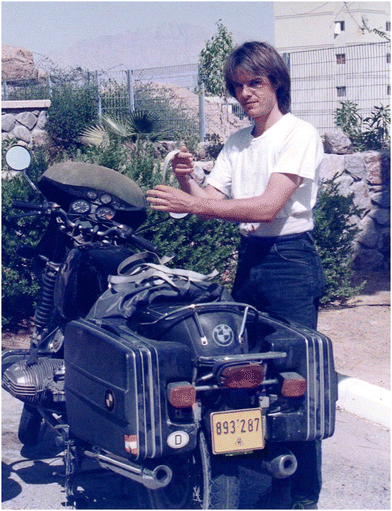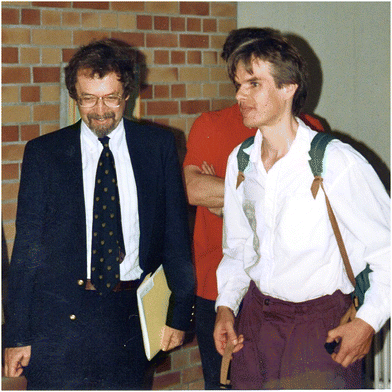Ullrich Steiner: portrait of the scientist as a young student
Jacob
Klein
Weizmann Institute of Science, Rehovot, Israel. E-mail: jacob.klein@weizmann.ac.il
Ulli was the first of over a dozen students from the group of Prof. Guenter Schatz in Konstanz University Physics Department who came to work in my lab, either for long working visits, or to carry out their Diplomarbeit research or to do a PhD., or, in several cases, both. Guenter Schatz was an outstanding nuclear physicist who was a good friend and great supporter and collaborator with the Weizmann Institute. Our scientific connection was through our work on applying nuclear reaction analysis (NRA) methods to study polymer physics, particularly interfacial structures, diffusion, wetting and phase separation. Ulli was the trailblazer of the Konstanz cohort who completed their experimental degree projects in my lab, many of whom went on to have distinguished academic careers of their own.
Ulli's Diplomarbeit work set the scene for his subsequent research in my group. We were using a Van de Graaff (VdG) particle accelerator, dating from 1957, with its original huge leather belt passing over metal brushes to generate what in the 1950's was considered a high voltage (up to ca. 750 kV). This instrument had long been abandoned by self-respecting nuclear physicists at the Weizmann, who had moved on to more modern accelerators at much higher energies, but in the hands of Ulli (with others) the very venerable vdG delivered marvelous new results in Soft Matter physics – over 25 publications from Ulli's Diplomarbeit and PhD alone (including papers in Science, several in Phys. Rev. Lett., and more in many other leading journals), an all-time record for graduate students in my group. Below I highlight some of the milestones in Ulli's early research progress.
Just before the time that Ulli arrived in my group, we had started, together with Kumar Chaturvedi, a post-doc in my group, to explore the exothermic nuclear reaction 2H + 3He ⇒ 1H + 4He, Q = 18.352 MeV, in the context of NRA on polymer thin films and interfaces. Once Ulli joined with Kumar, who was about to return to India, the work progressed fast, and our first paper using this technique, on interfacial structure in polymer mixtures (Phys. Rev. Lett., 1989)1 was submitted within 5 months of Ulli commencing his Diplomarbeit in my lab (see Fig. 1).
This rapid pace of experimental research and obtaining results, analysis of data, writing up and submitting for publication, very much characterized Ulli’s work over the time he was with me. Other papers on interfacial structure followed, following which Ulli moved to study the time dependence and, from that, the dynamics of mixing of different polymers (Phys. Rev. Lett., 1990).2
The nanometer spatial resolution available with NRA of polymer thin films enabled Ulli to study surface segregation from polymer mixtures in great detail, and he exploited this to examine complete wetting from such mixtures for the first time (Science 1994).3 Later he examined the time (t) dependence of such wetting, demonstrating a remarkable power dependence of the wetting thickness, which varied as tp, with an exponent p = 0.25–0.2 (Phys. Rev. Lett., 1996).4 The work on wetting, surfaces and polymer mixtures led naturally to the discovery of surface phase-inversion phenomena (Phys. Rev. Lett., 1994).5
Now, about the motorcycle and its connection to Ulli's nuclear reaction analysis experiments… Ulli was very attached to this machine (Fig. 2), but because of its age he was not allowed to import it formally, only as a visitor for one year at a time. We adopted a creative solution to this, which involved my writing to the Customs authorities once a year “explaining” the urgent need we had of this motorcycle for our NRA experiments, and so Ulli was able to happily keep his motorcycle for his entire period in Israel. As is well known, happy students are also very productive ones, and finally, almost exactly 30 years ago, Ulli submitted his thesis and passed his PhD viva with flying colours (Fig. 3). The rest, as they say, is history.
Best wishes for your 60th birthday, Ulli, and for many more productive years of science!
Acknowledgements
I thank Michele Klein and Tom Klein for their help with this brief memoir.References
- U. K. Chaturvedi, U. Steiner, O. Zak, G. Krausch and J. Klein, Interfacial structure in polymer mixtures below the critical point, Phys. Rev. Lett., 1989, 63, 616–619, DOI:10.1103/PhysRevLett.63.616.
- U. Steiner, G. Krausch, G. Schatz and J. Klein, Dynamics of mixing between partially miscible polymers, Phys. Rev. Lett., 1990, 64, 1119–1121, DOI:10.1103/PhysRevLett.64.1119.
- U. Steiner, J. Klein, E. Eiser, A. Budkowski and L. J. Fetters, Complete wetting from polymer mixtures, Science, 1992, 258, 1126–1129 CrossRef CAS PubMed.
- U. Steiner and J. Klein, Growth of Wetting Layers from Liquid Mixtures, Phys. Rev. Lett., 1996, 77, 2526–2529, DOI:10.1103/PhysRevLett.77.2526.
- U. Steiner, J. Klein and L. J. Fetters, Surface phase inversion in finite-sized binary mixtures, Phys. Rev. Lett., 1994, 72, 1498–1501, DOI:10.1103/PhysRevLett.72.1498.
| This journal is © The Royal Society of Chemistry 2024 |



